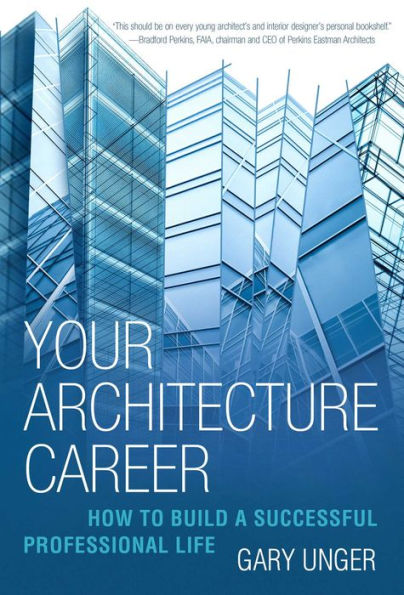Master the business side of architecture with advice from an expert.
In Your Architecture Career, Gary Unger provides tips and guidance to students, interns, architects, and firm owners to help them understand and master the business side of architecture and interior design. Students in school are not taught to manage process, projects, and clients—the emphasis is on design. However, most graduates will not finish their careers as designers. Rather, their focus will be on marketing, programming, project management, cost estimating, rendering, virtual reality, drawing documentation, specifications, workplace strategy, and construction administration. Gary Unger expertly describes the creative aspects of these disciplines and the considerable value they bring to a firm.
In order to accurately represent how an architecture firm successfully operates, Gary stresses the importance of teamwork. With project teams made up of architects, engineers, realtors, building owners, contractors, furniture dealers, and more, it is important to note that a project's success is measured by how well handoffs of information are executed both inside a firm as well as from firm to firm. Spanning a wide variety of topics, chapters include:
Completing architectural school Deciding on a career path Landing your first job Building your reputation Managing handoffs RFPs and proposals Reassessing your career Starting your own firm
Whether you're a student about to graduate or a seasoned professional, Your Architecture Career is an invaluable resource for the business side of architecture.
1126849568
In Your Architecture Career, Gary Unger provides tips and guidance to students, interns, architects, and firm owners to help them understand and master the business side of architecture and interior design. Students in school are not taught to manage process, projects, and clients—the emphasis is on design. However, most graduates will not finish their careers as designers. Rather, their focus will be on marketing, programming, project management, cost estimating, rendering, virtual reality, drawing documentation, specifications, workplace strategy, and construction administration. Gary Unger expertly describes the creative aspects of these disciplines and the considerable value they bring to a firm.
In order to accurately represent how an architecture firm successfully operates, Gary stresses the importance of teamwork. With project teams made up of architects, engineers, realtors, building owners, contractors, furniture dealers, and more, it is important to note that a project's success is measured by how well handoffs of information are executed both inside a firm as well as from firm to firm. Spanning a wide variety of topics, chapters include:
Whether you're a student about to graduate or a seasoned professional, Your Architecture Career is an invaluable resource for the business side of architecture.
Your Architecture Career: How to Build a Successful Professional Life
Master the business side of architecture with advice from an expert.
In Your Architecture Career, Gary Unger provides tips and guidance to students, interns, architects, and firm owners to help them understand and master the business side of architecture and interior design. Students in school are not taught to manage process, projects, and clients—the emphasis is on design. However, most graduates will not finish their careers as designers. Rather, their focus will be on marketing, programming, project management, cost estimating, rendering, virtual reality, drawing documentation, specifications, workplace strategy, and construction administration. Gary Unger expertly describes the creative aspects of these disciplines and the considerable value they bring to a firm.
In order to accurately represent how an architecture firm successfully operates, Gary stresses the importance of teamwork. With project teams made up of architects, engineers, realtors, building owners, contractors, furniture dealers, and more, it is important to note that a project's success is measured by how well handoffs of information are executed both inside a firm as well as from firm to firm. Spanning a wide variety of topics, chapters include:
Completing architectural school Deciding on a career path Landing your first job Building your reputation Managing handoffs RFPs and proposals Reassessing your career Starting your own firm
Whether you're a student about to graduate or a seasoned professional, Your Architecture Career is an invaluable resource for the business side of architecture.
In Your Architecture Career, Gary Unger provides tips and guidance to students, interns, architects, and firm owners to help them understand and master the business side of architecture and interior design. Students in school are not taught to manage process, projects, and clients—the emphasis is on design. However, most graduates will not finish their careers as designers. Rather, their focus will be on marketing, programming, project management, cost estimating, rendering, virtual reality, drawing documentation, specifications, workplace strategy, and construction administration. Gary Unger expertly describes the creative aspects of these disciplines and the considerable value they bring to a firm.
In order to accurately represent how an architecture firm successfully operates, Gary stresses the importance of teamwork. With project teams made up of architects, engineers, realtors, building owners, contractors, furniture dealers, and more, it is important to note that a project's success is measured by how well handoffs of information are executed both inside a firm as well as from firm to firm. Spanning a wide variety of topics, chapters include:
Whether you're a student about to graduate or a seasoned professional, Your Architecture Career is an invaluable resource for the business side of architecture.
14.99
In Stock
5
1

Your Architecture Career: How to Build a Successful Professional Life
272
Your Architecture Career: How to Build a Successful Professional Life
272Related collections and offers
14.99
In Stock

From the B&N Reads Blog
